Giftware
Summer Atlanta Market Means Business
Atlanta Market kicks off an unprecedented summer market season with new dates and a modified format that will allow retailers and designers to source needed new product during their recovery from the COVID-19 crisis. The 2020 summer market will be staged August 13-18, 2020 at AmericasMart® Atlanta, with buying across its complete product collection alongside introduction of new enhanced safety protocols.
“With renewed strength and focus, we are moving forward to help our community get back to business,” said Bob Maricich, International Market Centers Chief Executive Officer. “While it is going to feel like a different type of market in Atlanta, the purpose remains the same: to connect the right buyers and the right sellers at the right time.”
Atlanta Market’s 1,000+ showrooms are set to be open throughout the six-day August market. The Gift collection – with general gift merchandise and specialty categories such as gourmet, housewares, tabletop, outdoor living, juvenile and seasonal – is presented on 19 floors in more than 700 showrooms. The Home Décor collection is presented on 12 floors with more than 300 showrooms presenting lighting, accent furniture, rugs, wall décor, casual furniture, linens and more.
Despite the COVID-19 crisis, the Atlanta NEXT campus improvement plan has continued, resulting in the summer 2020 launch of a new lifestyle destination on the 11th floor of Building 2 and continued refinements to the Building 1 home décor collection. Additionally, work continues on the Building 1 lobby in preparation for its Winter 2021 debut but will have minor disruptions on the summer 2020 market. More information about Atlanta NEXT is available at AmericasMart.com/AtlantaNEXT.
Complementing the permanent showroom resources are temporaries showcasing a range of gift, home décor, gourmet, tabletop, seasonal and fashion merchandise, presented August 14-17 in a modified format that allows for social distancing and traffic management.
Guided by buyer sentiment, the Summer market’s educational programming and trend presentations will be presented exclusively online for 2020. In the months leading up to market, Atlanta Market will present educational webinars that emulate at-market seminars. From safety protocol to trends talks and social media training, buyers will be ready to arrive at market with all necessary information to have a safe and productive experience. During market, Atlanta Market will take to social media to present daily videos featuring showrooms, temporary exhibitors, safety policies and campus tours. A full schedule of virtual programming will be announced in the coming weeks.
Votes for Women Collection Celebrates a Century of Struggle
By Lorrie Baumann
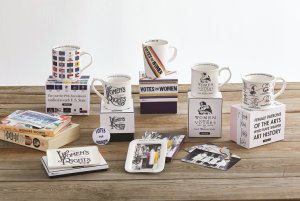 Rosanna is celebrating the 100th anniversary of women’s right to vote in the U.S. with the creation of its Votes for Women collection, the fourth in a series of collections acknowledging women’s progress. Owner Rosanna Bowles created the collection to remind women that it’s only in the last 100 years that American women have been regarded as equal citizens in this country. “People don’t understand how far women have come,” she said. “Millennials and Generation Z may not know that in 1970, a woman couldn’t get a credit card without her husband’s signature.”
Rosanna is celebrating the 100th anniversary of women’s right to vote in the U.S. with the creation of its Votes for Women collection, the fourth in a series of collections acknowledging women’s progress. Owner Rosanna Bowles created the collection to remind women that it’s only in the last 100 years that American women have been regarded as equal citizens in this country. “People don’t understand how far women have come,” she said. “Millennials and Generation Z may not know that in 1970, a woman couldn’t get a credit card without her husband’s signature.”
American women gained the right to vote in national elections through the 19th Amendment to the U.S. Constitution, which was ratified on August 18, 1920 after almost a century of political activism around the issue. The movement for women’s rights launched on a national level with the Seneca Falls Convention organized by Elizabeth Cady Stanton and Lucretia Mott in 1848 and continues today.
Following the 1848 convention, Stanton and Mott, along with Susan B. Anthony and other activists, raised public awareness and lobbied the government to grant voting rights to women. By 1878, the collective suffrage movement had gathered enough influence to lobby the U.S. Congress for a constitutional amendment granting women the right to vote, but when the proposal finally reached the Senate floor in 1886, it was defeated. Suffragists turned to lobbying individual states, and by 1918, 20 states, mostly in the western U.S., and the Alaska territory had enfranchised women.
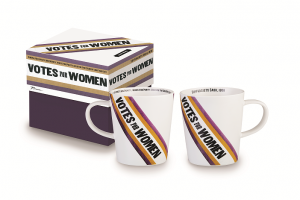 The election of Woodrow Wilson and the United States’ entry into World War I brought the issue back to Washington, D.C. and on May 21, 1919, the U. S. House of Representatives approved the Susan Anthony Amendment granting women the right to vote in a 304-89 vote, 42 votes above the required two-thirds majority. On June 4, 1919, the U.S. Senate passed the 19th Amendment by two votes over its two-thirds required majority, 56-25, and the amendment was sent to the states for ratification. The Amendment reads, in its entirety, “The right of citizens of the United States to vote shall not be denied or abridged by the United States or by any state on account of sex. Congress shall have power to enforce this article by appropriate legislation.”
The election of Woodrow Wilson and the United States’ entry into World War I brought the issue back to Washington, D.C. and on May 21, 1919, the U. S. House of Representatives approved the Susan Anthony Amendment granting women the right to vote in a 304-89 vote, 42 votes above the required two-thirds majority. On June 4, 1919, the U.S. Senate passed the 19th Amendment by two votes over its two-thirds required majority, 56-25, and the amendment was sent to the states for ratification. The Amendment reads, in its entirety, “The right of citizens of the United States to vote shall not be denied or abridged by the United States or by any state on account of sex. Congress shall have power to enforce this article by appropriate legislation.”
By March of the following year, a total of 35 states had approved the amendment. Tennessee became the state that supplied the three-fourths majority required to ratify the amendment on a 49-48 vote, with the deciding vote cast by Harry T. Burn, a Republican Representative from McMinn County. On August 26, 1920, the 19th Amendment was certified by U.S. Secretary of State Bainbridge Colby. Mississippi became the last state to ratify the 19th Amendment in 1984.
Through her Votes for Women collection memorializing the ratification of the 19th Amendment, Bowles intended to honor and raise awareness around that history rather than to make a political statement. “I’m a mother of two daughters,” she said. “I wanted to do a product that would make women feel empowered. The mugs make a statement to celebrate how much women have accomplished…. We’re retelling history, and, hopefully, it will help young women understand how far we’ve come.”
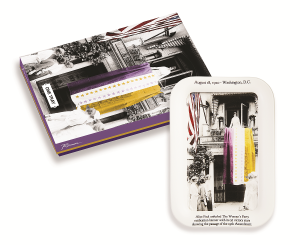 While some of the mugs feature simple slogans commemorating the anniversary, others feature graphic imagery authentic to the era of the women’s suffrage fight, gathered from authentic ephemera of the period in Bowles’ collection. “Women bring all Voters into the World. Let women vote” was a sign that women put in their homes, for instance. The “Votes for Women” mug is adorned in the colors of the sash worn by suffragists when they marched in parades.
While some of the mugs feature simple slogans commemorating the anniversary, others feature graphic imagery authentic to the era of the women’s suffrage fight, gathered from authentic ephemera of the period in Bowles’ collection. “Women bring all Voters into the World. Let women vote” was a sign that women put in their homes, for instance. The “Votes for Women” mug is adorned in the colors of the sash worn by suffragists when they marched in parades.
Rosanna’s Votes for Women collection joins previous collections in the series: Phenomenal Women; You Go Girl; and Ladies Choice. Items in the collections, which are all currently offered, are available as mugs, totes, travel mugs and trays. All of them appeal to women who shop with their values as well as their dollars. “People don’t want to buy stuff – they want to buy something that means something,” Bowles said. “When one of these mugs sits on your desk, it makes a statement about who you are. These collections tell stories about the women who make them and the women who buy and use them.”
For more information about the Votes for Women collection as well as other items in the Rosanna tableware and home décor collections, visit www.rosannainc.com.
JK Adams’ 76th Anniversary Year Brings New Introductions
By Lorrie Baumann
JK Adams is celebrating its 76th anniversary this year with 35 new items, many of them contemporary updates on the company’s heritage cutting board designs. The company is continuing this year with a marketing strategy that emphasizes the gift channel, and the new collections can be seen this summer at the Las Vegas Market and the Atlanta Market.
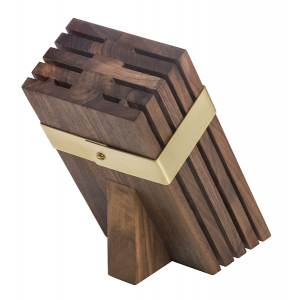 JK Adams is bringing back its popular Dorset Blocks, which feature slots equipped with heavy duty magnets to keep knives secure while they’re stored. The company is also reintroducing its slanted knife rack in walnut – this time with a brass band around it that lends an elegant note to the contemporary feel of the rack. “We felt that if we were going to reintroduce it, it had to be special, and I think the brass accent really does that for us,” said Sharon Rishell, JK Adams’ National Sales Manager.
JK Adams is bringing back its popular Dorset Blocks, which feature slots equipped with heavy duty magnets to keep knives secure while they’re stored. The company is also reintroducing its slanted knife rack in walnut – this time with a brass band around it that lends an elegant note to the contemporary feel of the rack. “We felt that if we were going to reintroduce it, it had to be special, and I think the brass accent really does that for us,” said Sharon Rishell, JK Adams’ National Sales Manager.
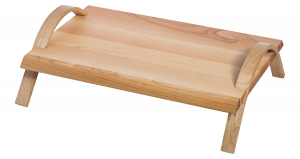 The new Stowe Maple Serving Tray offers bentwood handles on either side of a generously sized 18-1/2 by 12-inch tray that’s 5 inches tall. At that height, it could easily be used for a breakfast in bed or a light supper in front of the television. In the home office, it would make a docking station for a laptop computer or the family’s collection of gadget chargers. It retails for $69.95.
The new Stowe Maple Serving Tray offers bentwood handles on either side of a generously sized 18-1/2 by 12-inch tray that’s 5 inches tall. At that height, it could easily be used for a breakfast in bed or a light supper in front of the television. In the home office, it would make a docking station for a laptop computer or the family’s collection of gadget chargers. It retails for $69.95.
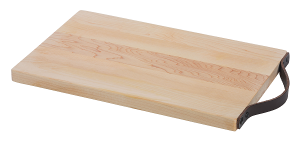 Leather handles adorn the Killington Boards, which are made with maple with the dark leather accent. Killington is offered in two sizes: a 14-inch by 9-inch rectangle and a 12-inch square. The Craftsbury Board is a simple maple bar board that measures 24 inches by 6 inches and will retail for around $47.
Leather handles adorn the Killington Boards, which are made with maple with the dark leather accent. Killington is offered in two sizes: a 14-inch by 9-inch rectangle and a 12-inch square. The Craftsbury Board is a simple maple bar board that measures 24 inches by 6 inches and will retail for around $47.
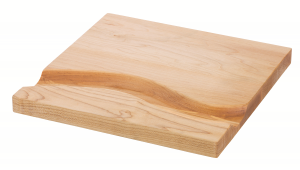 Honoring the importance of the cheese board for today’s home entertainers, JK Adams introduces two gorgeous cheese trays with channels that divide the space and offer a nesting spot for crackers. Shelburne and Mad River are both made from maple.
Honoring the importance of the cheese board for today’s home entertainers, JK Adams introduces two gorgeous cheese trays with channels that divide the space and offer a nesting spot for crackers. Shelburne and Mad River are both made from maple.
JK Adams is also bringing back its Butterfly Boards in both walnut and maple. These boards are reversible, with a juice groove on one side and a flat surface on the other. They’re offered in two sizes. The 18-inch by 11-inch by 1-inch board retails for around $70 in maple and around $110 in walnut. The 18-inch by 7-inch by 1-inch board retails for around $55 in maple and around $79 in walnut.
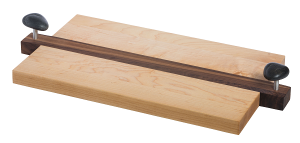 The company has partnered with New Hampshire–based Sea Stones to create contemporary serving pieces that feature stone handles. The Lake Champlain Serving Tray is made in an elegant combination of maple and walnut to offer a choice with the elegance of walnut but the friendlier price point of maple. The 18-inch by 9-inch tray retails for about $95, while the 24-inch by 12-inch tray retails for about $115.
The company has partnered with New Hampshire–based Sea Stones to create contemporary serving pieces that feature stone handles. The Lake Champlain Serving Tray is made in an elegant combination of maple and walnut to offer a choice with the elegance of walnut but the friendlier price point of maple. The 18-inch by 9-inch tray retails for about $95, while the 24-inch by 12-inch tray retails for about $115.
Moving down the price spectrum, JK Adams is also bringing out three new collections of lasered appetizer boards decorated with designs of flowers, fruits and geometric patterns that are lasered into them. They’re then painted with a food-safe milk paint to bring out the design, and then the boards are finely sanded to etch off the paint outside the lasered lines. The Flowers collection includes Dahlia, Gerber Daisy and Daylily. The Fruits collection includes Limes, Apples and Cherries. The boards measure 6 inches by 8 inches and will retail for around $28.
Spherificator Brings Culinary Wizardry to Home Cooks
By Lorrie Baumann
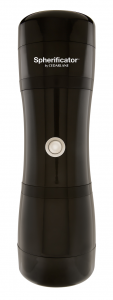 This year at The Inspired Home Show, Cedarlane Culinary had intended to build on the buzz its Spherificator created at last year’s show, but those plans, as is the case with so many, were foiled by the COVID-19 pandemic. The Spherificator is a device for transforming drops of liquid into the trendy pearls that high-end chefs have taken to using as garnishes for all manner of dishes. Taking cues from molecular gastronomists, now home cooks can use the Spherificator to garnish sushi with ginger pearls, decorate chocolate mousse with coffee caviar or drop rum pearls onto eggnog. “Richard Blais does horseradish caviar, freezes it in liquid nitrogen and serves it on oysters so it comes out smoking from the nitrogen,” said Dustin Skeoch, co-Founder of Cedarlane Culinary. “I’ve seen other chefs that will make 10 to 15 different flavors of pearls and serve them all as a pearl salad.”
This year at The Inspired Home Show, Cedarlane Culinary had intended to build on the buzz its Spherificator created at last year’s show, but those plans, as is the case with so many, were foiled by the COVID-19 pandemic. The Spherificator is a device for transforming drops of liquid into the trendy pearls that high-end chefs have taken to using as garnishes for all manner of dishes. Taking cues from molecular gastronomists, now home cooks can use the Spherificator to garnish sushi with ginger pearls, decorate chocolate mousse with coffee caviar or drop rum pearls onto eggnog. “Richard Blais does horseradish caviar, freezes it in liquid nitrogen and serves it on oysters so it comes out smoking from the nitrogen,” said Dustin Skeoch, co-Founder of Cedarlane Culinary. “I’ve seen other chefs that will make 10 to 15 different flavors of pearls and serve them all as a pearl salad.”
The Spherificator isn’t actually new – an industrial version of the device was developed in Montreal by an inventor who used it to make Kelp Caviar, a cheaper substitute for real roe. Cedarlane Culinary acquired the company in 2018 and then impressed crowds at last year’s International Home + Housewares Show. “The booth was packed the whole show. We had tons of international distributors that we’d never heard of, and we found some American independent retailers and larger chains who wanted to take it on as well,” Skeoch said. “It was easily the best housewares show we’ve ever done.”
 The Spherificator retails for $99 and comes with the device plus enough of the sodium alginate and calcium chloride that make the gel membrane that encapsulates the liquid to make enough pearls for about 50 dinner parties. After the supplies that come in the box have been exhausted, more is available from Cedarlane in Canada or Modernist Pantry in the U.S. The Spherificator also comes with a recipe booklet of 18 chef-developed recipes.
The Spherificator retails for $99 and comes with the device plus enough of the sodium alginate and calcium chloride that make the gel membrane that encapsulates the liquid to make enough pearls for about 50 dinner parties. After the supplies that come in the box have been exhausted, more is available from Cedarlane in Canada or Modernist Pantry in the U.S. The Spherificator also comes with a recipe booklet of 18 chef-developed recipes.
For the retailer, it’s a device that demonstrates well in the shop. “Seeing it in person really helps,” Skeoch said. “You can use just about any food or liquid and turn it into perfectly consistent caviar pearls to take your plating and presentation up a few notches.”
To make the pearls, the user mixes liquid with sodium alginate, a natural seaweed extract in the form of a powder that’s blended into the liquid. It thickens the liquid just a little bit. “You put that in the top of the machine,” Skeoch said. “Then you push the button on the machine, and it comes out as perfect little droplets.”
Those droplets fall into a bath made with the calcium chloride, a natural salt that’s a close relative of table salt, and water. “Each little droplet, when it hits the water, the calcium reacts with the alginate to form a thin membrane around each drop,” Skeoch said. “You can do this the old-fashioned way with a syringe or squeeze bottle slowly dripping one drop at a time into the bath, but it takes forever, so people who have done it that way in the past absolutely love how quickly our new version pumps them out!”
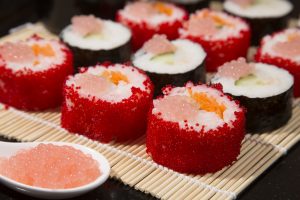 When the pearls are bitten, the liquid inside gushes out in a burst of flavor, so they’re a functional ingredient in the dish, but their primary appeal is in elegant presentation – and, of course, as a way for a dinner party host to make a splash. “You get a hit of flavor with every bite, but it’s really all about the visuals,” Skeoch said. “It’s an easy way for a foodie to elevate the plating. You don’t see this kind of advanced plating at most dinner parties.”
When the pearls are bitten, the liquid inside gushes out in a burst of flavor, so they’re a functional ingredient in the dish, but their primary appeal is in elegant presentation – and, of course, as a way for a dinner party host to make a splash. “You get a hit of flavor with every bite, but it’s really all about the visuals,” Skeoch said. “It’s an easy way for a foodie to elevate the plating. You don’t see this kind of advanced plating at most dinner parties.”
Upcycled Treasures from Koru Street
By Lorrie Baumann
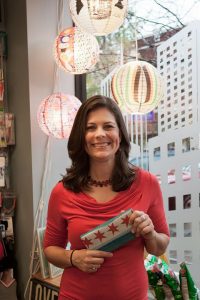 Amy Stretmater had one of those advertising jobs where the job is only as secure as the account you’re working on, and when she began to see that the account wasn’t going to be there anymore, she decided to take the opportunity to pick up and leave the country for six months. “I thought, ‘Where could I go that I can’t go on an American two-week vacation?’” she said.
Amy Stretmater had one of those advertising jobs where the job is only as secure as the account you’re working on, and when she began to see that the account wasn’t going to be there anymore, she decided to take the opportunity to pick up and leave the country for six months. “I thought, ‘Where could I go that I can’t go on an American two-week vacation?’” she said.
Since she’d already done quite a bit of traveling in Europe, she decided to go in another direction. “Leaving in September, I thought it would be better to go to the Southern Hemisphere, if for no other reason than that I didn’t have as much clothing with me,” she said.
She settled on New Zealand as a starting place, and then traveled into Asia. She was in Cambodia, about two-thirds of the way through her trip, when she noticed as she and her friend were taking a tuk tuk during a visit to Angkor Wat that she was seeing everywhere around her the workmanship of people who believed in re-purposing and reusing objects rather than simply throwing them away when they’d fulfilled the purpose for which they were originally created. It struck her that that’s quite different from the American culture in which she’d grown up. “We trade in our phone if it’s a year old,” she said.
That observation was still at the back of her mind when she left Cambodia to visit a friend who was living in Delhi, India, as a consular officer employed at the U.S. embassy. There, she visited a native market and learned about Conserve India, an organization that employs and trains hundreds of people from Delhi’s most disadvantaged communities to turn discarded plastic bags into upcycled products. The organization “works with artisans in the slums who are rag-pickers. One skill they have is where to find the good garbage,” Stretmater said.
Stretmater bought gifts for friends as well as a few things for herself from Conserve’s booth in the market, including a wallet that was in her hand when she paid for a meal after dinner with a friend once she was back in the United States and wondering what she was going to do with the rest of her life. “I thought, ‘I’ve got to find something to do with what I have learned,’” she said. “You don’t come home from six months away and go back to regular life – you have to change one little thing.”
Her friend noticed the wallet and commented on it, and it was at that moment that Stretmater knew what she wanted to do next, which was to help Conserve by importing some of its goods and selling them in a few local markets as a side project. “I think it would be good to talk about in job interviews,” she said.
Then store owners who saw the Conserve products in Stretmater’s market booths started asking if she sold wholesale. “Eventually, it became a full-time business,” she said. “I never got around to looking for that full-time job.”
Today, Stretmater is the owner of Koru Street, and she’s still traveling the world looking in local markets for artisans who create unusual gift items from recycled materials, especially materials that would normally go into the garbage. “I’m always trying to do things that are a little bit different, something more modern, something that I haven’t already seen here,” she said. “They do the design. The only thing I design is if I have to tweak something to make it work for the American market…. I want to use their skill set at designing everything.”
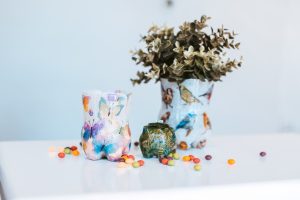 Among the items that Koru Street was offering this winter in the pavilions at the Las Vegas Market and in the Global Design area at The Atlanta International Gift & Home Furnishings Market was the klikety klik box, a gift box handmade in South Africa from discarded plastic bottles. It can be used closed as a gift box, or when it’s open, it can be used as a vase or an LED candle holder. Designs include birds, butterflies, flowers, seaside, kitchen and graphics. Three sizes are available, and retail prices range from $9 to $15.
Among the items that Koru Street was offering this winter in the pavilions at the Las Vegas Market and in the Global Design area at The Atlanta International Gift & Home Furnishings Market was the klikety klik box, a gift box handmade in South Africa from discarded plastic bottles. It can be used closed as a gift box, or when it’s open, it can be used as a vase or an LED candle holder. Designs include birds, butterflies, flowers, seaside, kitchen and graphics. Three sizes are available, and retail prices range from $9 to $15.
Stretmater is also still working with Conserve, and from them, she’s importing bags in sizes ranging from small purses through messenger bags as well as wallets like the one that sparked the idea to start her business after her friend commented on it. They’re made from a variety of materials, including plastic bags, inner tubes, seat belts and tent canvas – all from India. Retail prices for the items range from $4.50 to $65, with the majority in the range between $4.50 and $15.

You must be logged in to post a comment.